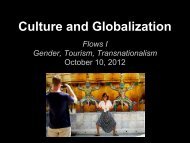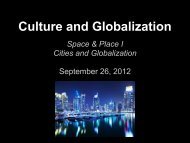Mimi Thi Nguyen, “The Biopower of Beauty: Humanitarian
Mimi Thi Nguyen, “The Biopower of Beauty: Humanitarian
Mimi Thi Nguyen, “The Biopower of Beauty: Humanitarian
You also want an ePaper? Increase the reach of your titles
YUMPU automatically turns print PDFs into web optimized ePapers that Google loves.
370 ❙ <strong>Nguyen</strong><br />
is this: if dignity is an intrinsic quality <strong>of</strong> being human, then self-esteem<br />
as a Foucauldian technology <strong>of</strong> the self is instrumental to its realization,<br />
to the maximization <strong>of</strong> that life.<br />
As the twentieth century witnessed the ascension <strong>of</strong> theories for rehabilitating<br />
damaged selfhood as a “science <strong>of</strong> democracy” (Rose 1998,<br />
116), the rational capacity to evaluate and esteem oneself according to<br />
these schema expanded into the field <strong>of</strong> the social and became normative<br />
in creating modern subjects. Self-esteem thus constitutes what is arguably<br />
a fundamental intervention in contemporary governmentality and in liberal<br />
feminism’s foundational maxim, “the personal is the political.” Barbara<br />
Cruikshank, reflecting on Gloria Steinem’s (1992) turn to “revolution<br />
from within,” identifies self-esteem as a technology <strong>of</strong> the self<br />
through which a direct causation between feeling good and doing good<br />
is made clear (1999, 87). Directed at purposes as specific as eliminating<br />
welfare dependency and as comprehensive as nurturing whole personhood,<br />
self-esteem in its gendered dimensions informs the will to empower<br />
through the transformative capacities <strong>of</strong> beauty for not only emotional<br />
well-being (feeling good) but also cultural competency (doing good):<br />
providing business-appropriate attire for low-income women, donating<br />
prom dresses to poor high school girls, granting makeovers to chemotherapy<br />
patients, or, in this instance, bestowing an education on Afghan<br />
women in the modern art and commerce <strong>of</strong> beauty. While the missions<br />
<strong>of</strong> these makeovers are not the same, they have in common techniques<br />
<strong>of</strong> esteeming the self and the premise that such techniques empower their<br />
target populations to correct, if not social harms and structural inequalities,<br />
then at least their own capacities for coping with dignity.<br />
I begin to trace here how beauty is instrumentalized as a pathway to<br />
feminine solidarity, in which the everyday care <strong>of</strong> the self and the dignity<br />
such care entails emerge together as a common concern. The integrity <strong>of</strong><br />
the feminine body and psyche becomes the goal <strong>of</strong> multiple forms <strong>of</strong><br />
global sisterhood, including its iteration as global feminism. In examining<br />
global feminism, then, as generating technologies <strong>of</strong> the self on a pathway<br />
to human rights, <strong>of</strong> particular concern are the trajectories producing<br />
knowledge and compelling empowerment tactics that come into existence<br />
at the intersection <strong>of</strong> biopolitics and geopolitics, especially those that connect<br />
self-esteem to liberal governance. Connecting passivity to poor selfimage<br />
and empowerment to a guided progress, global feminism, in its<br />
claim to universal applicability, comprises a set <strong>of</strong> discourses and practices<br />
that elides the structuring violences <strong>of</strong> geopolitics and transnational capital<br />
in favor <strong>of</strong> a liberal ideal <strong>of</strong> women’s freedom that celebrates individuality<br />
and modernity (Kaplan 1999; Grewal 2005). In doing so, global feminism





